Graptopetalum is a genus that includes other smaller hybrid genera, such as Graptophytums and Graptosedums. However, because of the variety in each genus, it’s important to stop and remember what makes each of them unique.
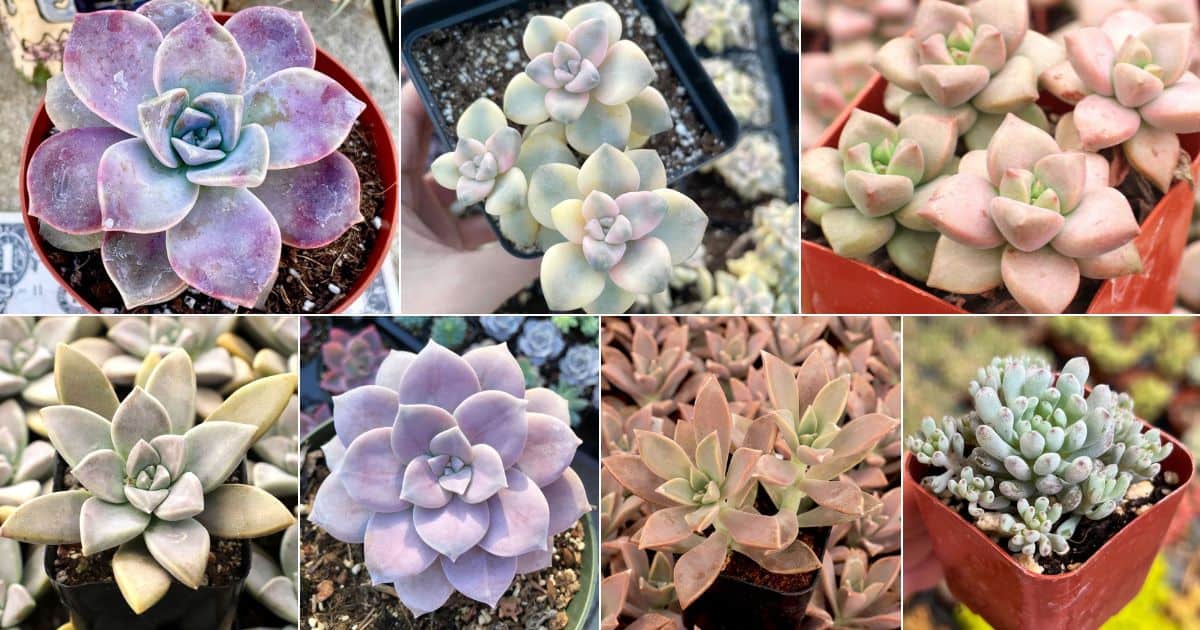
For Graptopetalum, compared to the hybrids underneath this genus, they have longer stems and naturally compact rosettes at the end of each stem. Some species branch more than others, and the branches are often quite substantial to support the rosettes at each end.
Are you ready to dive into these extremely hardy leatherleaf plants? Let’s go!
Jump to:
- 1. Graptopetalum titubans
- 2. Purple Superbum
- 3. Graptopetalum paraguayense
- 4. Blue Beans
- 5. Mirinae
- 6. Purple Delight
- 7. Graptopetalum rusbyi
- 8. Murasaki
- 9. Graptopetalum amethystinum
- 10. Graptopetalum Victor Kane
- 11. Graptopetalum Claret
- 12. Graptopetalum mendozae
- 13. Graptopetalum bellum
- 14. Purple Haze
- 15. Graptopetalum saxifragoides
1. Graptopetalum titubans

Buy it from:
| Maximum Height | 3 inches |
| Maximum Width | 3 inches |
| Watering Needs | When soil is dry or leaves are shriveling |
| Soil Needs | Well-draining soil with sand or grit |
| Light Needs | Full sun |
| Hardiness Zone(s) | Zone 10 and up |
| Bloom Color | Yellow |
| Bloom Type | Star-shaped |
| Leaf Type | Spoon-shaped that reach away from the center; very fleshy. |
| Growth Type | Compact rosette that forms mats |
A gorgeous cross between Graptopetalum paraguayense and Echevería derenbergii, the Porcelain Plant is a beautiful, antique-looking plant. Each rosette has a few leaves but variegated or not, they take on the textural appearance of freshly fired porcelain. The tips of the leaves can take on a pinkish tinge against the pastel green main color, which adds to its charm.
2. Purple Superbum

Buy it from:
| Maximum Height | 3 inches |
| Maximum Width | 6 inches |
| Watering Needs | When soil is dry or leaves are shriveling |
| Soil Needs | Well-draining soil with sand or grit |
| Light Needs | Full sun |
| Hardiness Zone(s) | Zone 10 and up |
| Bloom Color | Yellow |
| Bloom Type | Star-shaped |
| Leaf Type | Circular with pointed ends |
| Growth Type | Shrubby flattened rosettes |
Also known as Graptopetalum superbum, this flattened rosette is very attractive alone or in an arrangement. The spoon-shaped leaves have a slight keel to them, but what makes this species so well-known is the pastel lavender leaves. They self-propagate through pups that form along the stem and continue to grow to form a succulent shrub.
3. Graptopetalum paraguayense

Buy it from:
| Maximum Height | 8 inches |
| Maximum Width | 6 inches |
| Watering Needs | When soil is dry or leaves are shriveling |
| Soil Needs | Well-draining soil with sand or grit |
| Light Needs | Full sun |
| Hardiness Zone(s) | Zone 10 and up |
| Bloom Color | White |
| Bloom Type | Star-shaped |
| Leaf Type | Linear with spoon-lie ends; thinner leaves with a terminal point |
| Growth Type | Easily offsetting compact rosettes |
The Mother of Pearl Plant is an excellent representative of the Graptopetalum genus. With flattened rosettes, spoon-like leaves, reaching stems, and the typical coating of farina, they are truly a sexy plant to collect! Their color is akin to G. titubans; however, there is more of a blue undertone which is what gives it its ethereal name, Ghost plant.
4. Blue Beans

Buy it from:
| Maximum Stem Length | 8 inches |
| Watering Needs | When soil is dry or leaves are shriveling |
| Soil Needs | Well-draining soil with sand or grit |
| Light Needs | Full sun |
| Hardiness Zone(s) | Zone 9 and up |
| Bloom Color | White and green with red stripes |
| Bloom Type | Star-shaped |
| Leaf Type | Cylindrical and linear; leaves reach upward |
| Growth Type | Branched stem with compact rosettes at the end of each stem |
Graptopetalum pachyphyllum earned the name Blue Beans thanks to the gorgeous pastel blue leaves it has. Each rosette can vary slightly as more mature leaves tend to take on a more pink tone to them. This is another easily branching species; however, they form mats rather than shrubs as compared to other Graptopetalum species.
5. Mirinae

Buy it from:
An offspring of Graptopetalum mendozae and Graptopetalum Pentandrum, G. ‘Mirinae’ is a great representation of smaller rosettes with far-reaching stems and elongated inflorescences. Together with the almost blushing pink leaves, this is a beautiful shrub that grows easily, if not slowly. It is one of few species that doesn’t produce root hairs either. How unique!
6. Purple Delight

Buy it from:
| Maximum Stem Length | 12 inches |
| Maximum Rosette Width | 4 inches |
| Watering Needs | When soil is dry or leaves are shriveling |
| Soil Needs | Well-draining soil with sand or grit |
| Light Needs | Full sun |
| Hardiness Zone(s) | Zone 10 and up |
| Bloom Color | White |
| Bloom Type | Star-shaped |
| Leaf Type | Spade shaped with slight inward curve |
| Growth Type | Well-propagating, stemmed, upward-reaching rosettes |
Snow White, Crystal, and Purple Delight all refer to the same multi-colored species of Graptopetalum. From lavender purples to deep blue-grey and even some pastel green, this species can’t pick a single color! Per usual for graptopetalums, this species has few leaves that form an upward-reaching rosette that sits atop mat forming stems.
7. Graptopetalum rusbyi

Buy it from:
| Maximum Height | 3 inches |
| Maximum Width | 3 inches |
| Watering Needs | When soil is dry or leaves are shriveling |
| Soil Needs | Well-draining soil with sand or grit |
| Light Needs | Full sun |
| Hardiness Zone(s) | Zone 10 and up |
| Bloom Color | Red or Pink |
| Bloom Type | Star-shaped |
| Leaf Type | Thick, tongue-like leaves with terminal points |
| Growth Type | Prolificfull rosettes |
Unlike other Graptopetalum species, G. rusbyi tends to have more leaves that make for a well-packed, extremely dense rosette. Unlike other Graptopetalum, this species tends to form more of a clump rather than a shrub or mat. Depending upon the stresses, G. rusbyi can turn a dusty pink or maintain a more purple-green color during less stressed conditions.
8. Murasaki
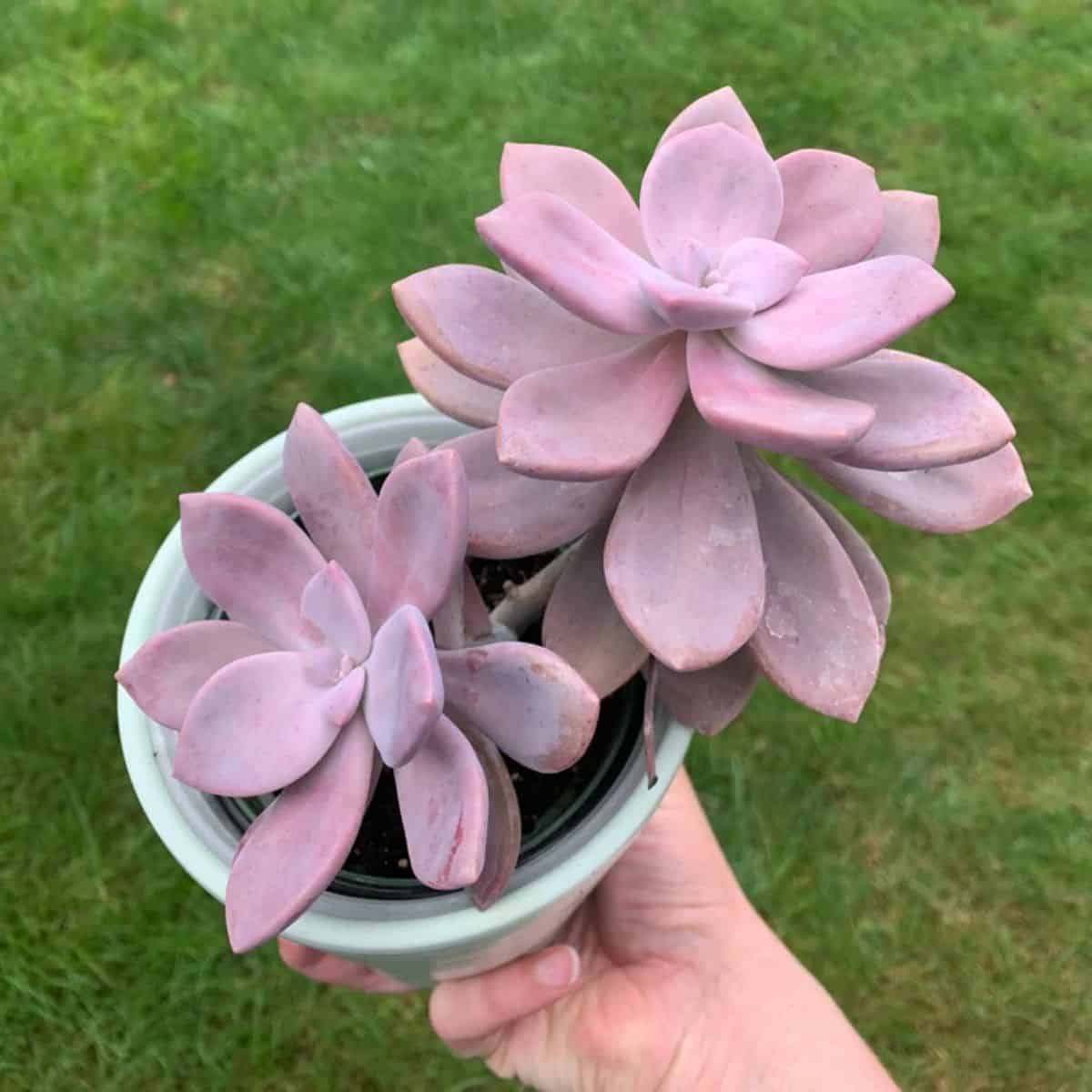
Buy it from:
| Maximum Height | 8 inches |
| Maximum Width | 4 inches |
| Watering Needs | When soil is dry or leaves are shriveling |
| Soil Needs | Well-draining soil with sand or grit |
| Light Needs | Full sun |
| Hardiness Zone(s) | Zone 10 and up |
| Bloom Color | Pink |
| Bloom Type | Star-shaped |
| Leaf Type | Thick spoon-shaped leaves with a small terminal spine. |
| Growth Type | Upward reaching rosette; easily propagated |
A variant of G. superbum, Murasaki has more rounded and reaching leaves as compared to the sister species. The colors are also virtually the same if it weren’t for the strong pink undertones in Murasaki. Their growth patterns are also similar, as Murasaki can grow more into a trailing or mat-like form.
9. Graptopetalum amethystinum

Buy it from:
| Maximum Stem Length | 1 foot |
| Maximum Rosette Width | 6 inches |
| Watering Needs | When soil is dry or leaves are shriveling |
| Soil Needs | Well-draining soil with sand or grit |
| Light Needs | Full sun |
| Hardiness Zone(s) | Zone 9 and up |
| Bloom Color | Pale yellow with red stripes; ends of petals are almost entirely red |
| Bloom Type | Star-shaped |
| Leaf Type | Thick teardrop-shaped leaves |
| Growth Type | Heavily branching stems with full rosettes |
Lavender Pebbles are rather interesting as they can grow in a variety of ways. Sometimes, the plant will split at the base and branch off there, or you can also find this species laying along the ground or trailing from pots. Light brown and purple give this species a more pastel purple with rare greenish tinges.
10. Graptopetalum Victor Kane
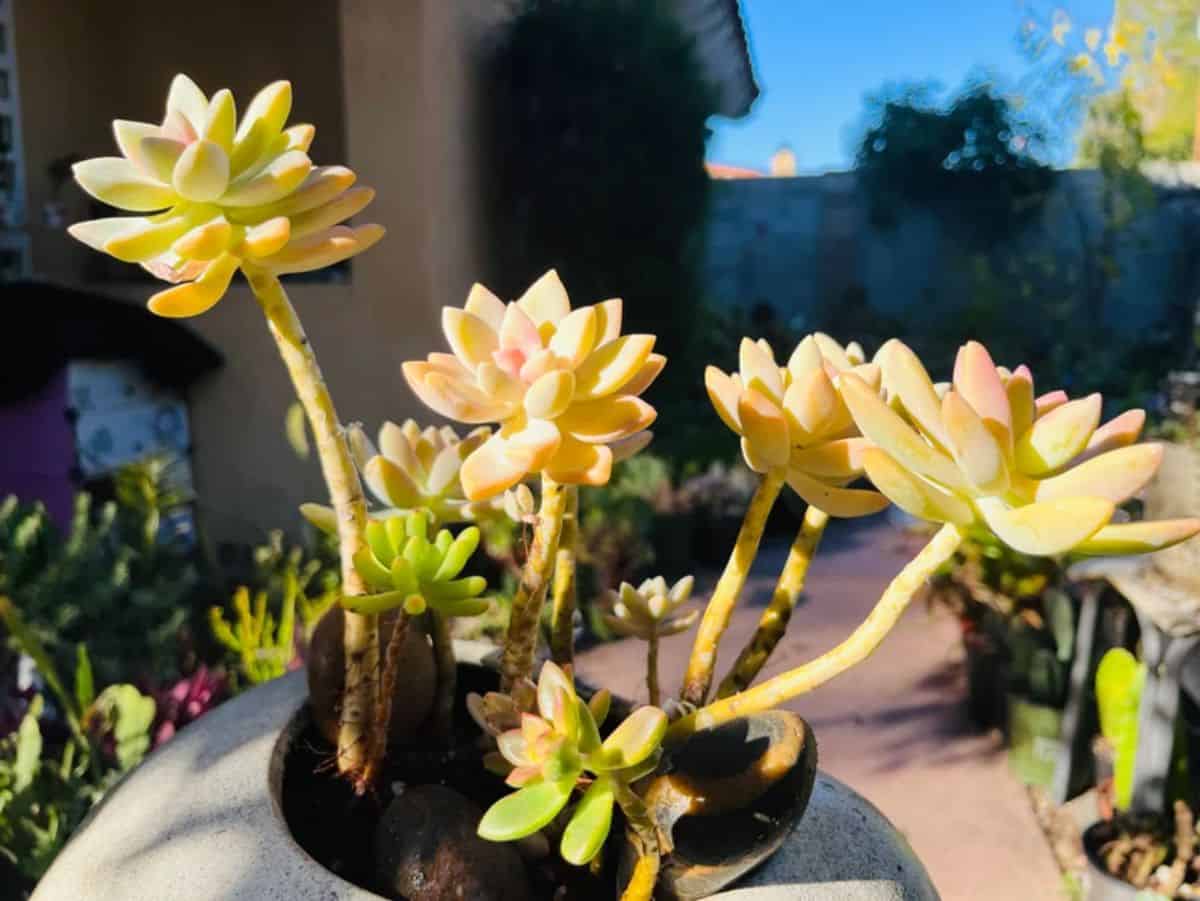
Buy it from:
| Maximum Stem Length | 12 inches |
| Maximum Rosette Width | 4 inches |
| Watering Needs | When soil is dry or leaves are shriveling |
| Soil Needs | Well-draining soil with sand or grit |
| Light Needs | Partial Sun |
| Hardiness Zone(s) | Zone 9 and up |
| Bloom Color | Pink |
| Bloom Type | Star-shaped |
| Leaf Type | Thick-keeled eaves with spoon-like triangle shape. |
| Growth Type | Sprawling stems with flat terminal rosettes with few leaves |
Also known as Graptopetalum ‘Frank Reinelt,’ this species can be very interesting thanks to the extremely strong stems that stand straight up for quite some time before becoming pendulous. With particularly leathery leaves, this species shows an array of colors, from light yellows and lime greens to deep copper pinks.
11. Graptopetalum Claret
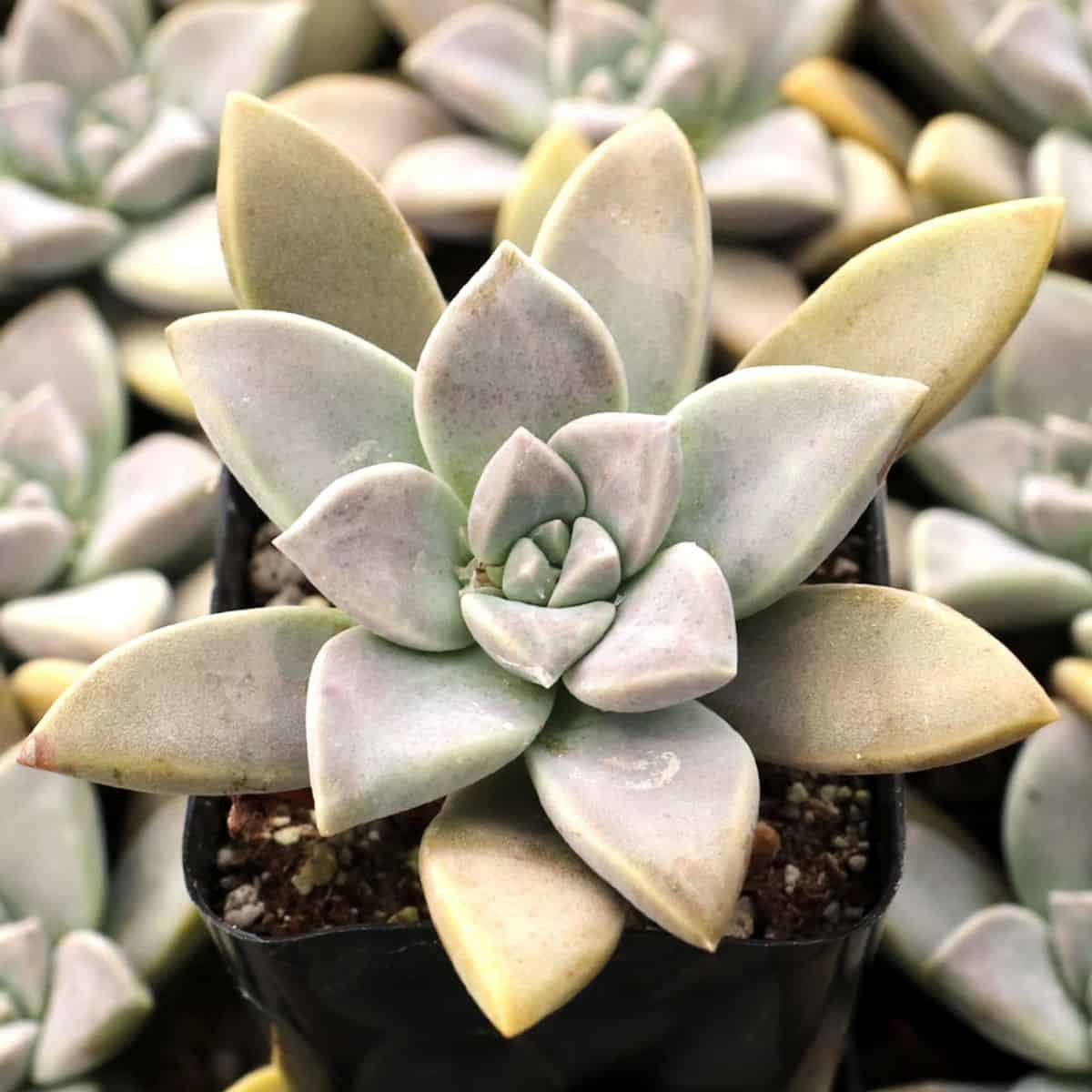
Buy it from:
| Maximum Height | 5 inches |
| Maximum Rosette Width | 4 inches |
| Watering Needs | When soil is dry or leaves are shriveling |
| Soil Needs | Well-draining soil with sand or grit |
| Light Needs | Full Sun |
| Hardiness Zone(s) | Zone 10 and up |
| Bloom Color | White with red speckles |
| Bloom Type | Star-shaped |
| Leaf Type | Triangular leaves |
| Growth Type | When soil is dry, or leaves are shriveling |
This species tends to look like a starburst on a stem. While the rosettes are flattened, the way the leaves arrange themselves makes this species look like a star. Color-wise, the base of the leaves can be minty green that fades to a light pastel purple. More mature leaves can take on a yellowish color as well.
12. Graptopetalum mendozae
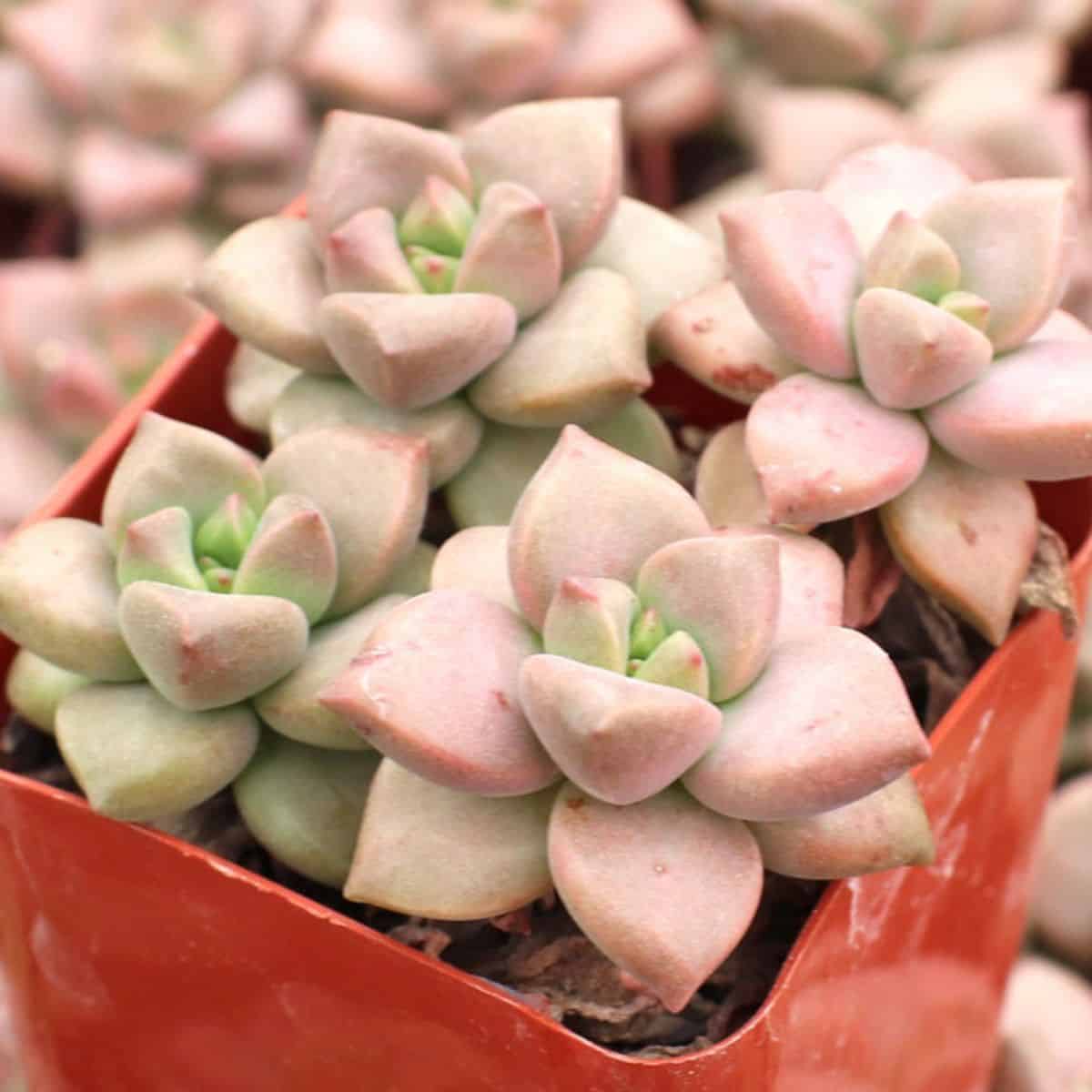
Buy it from:
| Maximum Height | 8 inches |
| Maximum Rosette Width | 1.5 inches |
| Watering Needs | When soil is dry or leaves are shriveling |
| Soil Needs | Well-draining soil with sand or grit |
| Light Needs | Full Sun |
| Hardiness Zone(s) | Zone 10 and up |
| Bloom Color | White |
| Bloom Type | Star-shaped |
| Leaf Type | Thick leaves with a pyramidal shape |
| Growth Type | Trailing rosettes |
One of the representatives of the species, G. mendozae is a clump-forming trailing rosette with perfect tiny rosettes. The rosettes are a pastel pink and do best in partial to full sun. More often than not, when this species is grown indoors, it looks more peachy than pink.
13. Graptopetalum bellum

Buy it from:
| Maximum height | 3 inches |
| Maximum Rosette Width | 4 inches |
| Watering Needs | When soil is dry or leaves are shriveling |
| Soil Needs | Well-draining soil with sand or grit |
| Light Needs | Filtered sun |
| Hardiness Zone(s) | Zone 10and up |
| Bloom Color | Hot Pink |
| Bloom Type | Star-shaped |
| Leaf Type | Triangular leaves |
| Growth Type | Flat compact rosettes |
An odd one in the Graptopetalum genus, G. bellum has very large rosettes and some of the largest flowers among others. It is considered to be a natural source of hummingbird food and will attract them to your garden. The deep violet backs of the leaves are accented by light green fronts with deep purple terminal points.
14. Purple Haze

Buy it from:
| Maximum Stem Length | 12 inches |
| Maximum Rosette Width | 4 inches |
| Watering Needs | When soil is dry or leaves are shriveling |
| Soil Needs | Well-draining soil with sand or grit |
| Light Needs | Filtered sun |
| Hardiness Zone(s) | Zone 10 |
| Bloom Color | Pink |
| Bloom Type | Star-shaped |
| Leaf Type | Linear to spoon-shaped; ends in a terminal tip or spine |
| Growth Type | Open rosettes on sprawling stems |
A cross of G. paraguayense x G. superbum, Graptopetalum Purple Haze, varies from its sister species Purple Delight in how the deep purple colorations appear. While G. Purple Delight has more splotches of purple, the purple haze looks as though the purple coloration is seen through a sepia filter. This gives the species a rusty purple look when under the right conditions.
15. Graptopetalum saxifragoides

| Maximum Rosette Width | 1.6 inches |
| Watering Needs | When soil is dry or leaves are shriveling |
| Soil Needs | Well-draining soil with sand or grit |
| Light Needs | Filtered sun |
| Hardiness Zone(s) | Zone 9 and up |
| Bloom Color | White to yellow with brownish-purple patterns |
| Bloom Type | Star-shaped |
| Leaf Type | Lance shaped leaves |
| Growth Type | Mat forming compact rosettes |
One of the rarer species to get a hold of, G. saxifragoides is an incredible example of variation in Graptopetalum. The leaves are lance-shaped and almost a key-lime green, but their beauty lies within the large flowers. While the flowers aren’t as large as G. bellum’s, they are equally stunning. With a white base and deep red bands and splotches, this species truly stuns!

